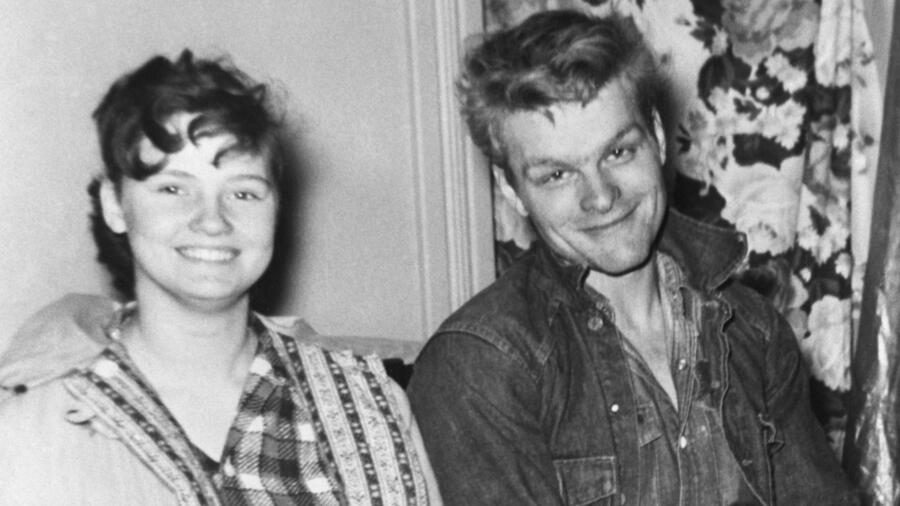In late January 1958, a wave of terror swept across Nebraska and Wyoming. A teenage couple—Charles “Charlie” Starkweather, 19, and his 14-year-old girlfriend, Caril Ann Fugate—left a trail of death that shocked the nation. Over just eight days, they murdered ten people, including Caril’s own family. But ever since their arrest, one critical question has haunted historians and true crime enthusiasts alike: Was Caril a willing accomplice—or a terrified hostage?
Although Charlie pulled the trigger in most of the murders, Caril’s presence throughout the killing spree raised eyebrows. Did she support the bloodshed? Or did fear chain her to a nightmare from which she couldn’t escape?
A Love Story Turned Deadly
The killings began on January 21, 1958. By the end of the month, ten people lay dead, including Caril’s mother, stepfather, and baby half-sister. The couple also murdered a traveling salesman, a 70-year-old farmer, two teenagers, a wealthy couple, and their maid. Most of the victims had no prior connection to either Charlie or Caril.
After their arrest, Charlie openly admitted to the murders. He even confessed to an earlier killing from December 1957. But his story changed often, especially when it came to Caril’s role. Sometimes, he claimed she helped. Other times, he insisted she had nothing to do with it.
Caril, however, told a different story from the start.
Her Side of the Story
According to Caril, Charlie had told her that her family was alive and being held hostage. Fearing for their safety—and her own—she stayed with him. She said she never had the chance to escape, and if she had tried, he might have killed her too.
But critics pointed to her behavior during the murders. She had multiple opportunities to run. She could have alerted the authorities. Instead, she remained by Charlie’s side as more victims fell.
The Trials That Shaped Their Fates
In May 1958, Charlie Starkweather was found guilty of murdering teenager Robert Jensen. He was sentenced to death. Just a few months later, Caril stood trial separately. The prosecution painted her as a co-conspirator, not a victim. They argued she had chances to escape but chose not to.
The jury believed them.
Caril received a life sentence for first-degree murder. Meanwhile, Charlie was executed in the electric chair on June 25, 1959. Caril served 18 years before being granted parole in 1976. Unlike Charlie, she never returned to crime.
The Legend Lives On
Their story didn’t end with the trial. The Starkweather-Fugate murders became one of America’s most infamous true crime cases. It inspired countless books, films, and even Bruce Springsteen’s Nebraska album.
Decades later, people still argue about Caril’s guilt. Was she complicit—or was she just a scared child under the control of a violent boyfriend?
A New Perspective Emerges
Author Harry MacLean, a Lincoln native, revisited the case in his book Starkweather. His connection was personal—his brother knew Charlie, and his family knew one of the victims.
MacLean didn’t just retell the story; he reexamined it through a modern psychological lens. He explored concepts like trauma bonding, coercion, and Stockholm Syndrome—terms virtually unknown in 1958.
According to MacLean, society in the 1950s couldn’t comprehend the idea that someone, especially a teenager, could be so traumatized that they lost the ability to choose freely.
“In Lincoln, almost everyone believed Caril was guilty,” he explained. “The idea that she was mentally overpowered by fear just didn’t exist back then.”
Innocence Lost or Guilt Concealed?
MacLean’s book reintroduces the argument that Caril may have suffered from extreme trauma. She was only 14. Her boyfriend had already killed her family, and she believed she could be next. Could that terror have rendered her incapable of escape or resistance?
Or was she, as prosecutors claimed, a willing participant who chose love and rebellion over morality?
The truth remains elusive.
America’s First Media-Crime Couple
Charlie and Caril’s saga played out in the national media. Their photos appeared on front pages nationwide. Reporters followed their every move, from the first murders to their dramatic arrests. Charlie—defiant and smiling—appeared to enjoy the spotlight. He styled himself after James Dean, a rebel with a death wish.
Caril, by contrast, looked like an ordinary young girl caught in something far too big for her to understand.
Together, they became America’s first “killer couple”—a template for infamous duos like Bonnie and Clyde, despite their stark differences.
The Legacy of Trauma
For survivors, the pain didn’t end when the killings stopped. Mike Ward, whose parents were among the victims, kept the truth hidden from his children for years. But eventually, he had to explain why their grandparents were no longer alive.
That conversation revealed just how deep the trauma still ran.
“I saw how it had shaped my daughter’s life,” Ward said. “And I realized it would affect her children too.”
What Would Charlie Think Today?
Charlie always dreamed of dying in a blaze of outlaw glory. He wanted to go out alongside Caril, the way he believed real criminals did. Instead, he died alone in the electric chair while Caril built a new life after prison.
Would he feel betrayed? Likely. Would he still claim Caril was an accomplice? Almost certainly.
But Charlie is long gone. Caril, now in her 80s, has stayed silent for years.
FAQs
Was Caril Ann Fugate convicted of murder?
Yes. In 1958, she was convicted of first-degree murder and sentenced to life in prison.
How old was Caril when the crimes happened?
She was 14 years old at the time of the killing spree.
Did Charlie Starkweather admit to all the murders?
He confessed to 11 murders, including one committed before the spree began.
What was Caril’s defense at trial?
She claimed she was a hostage and stayed with Charlie out of fear for her life.
Did Caril ever commit another crime?
No. After her release in 1976, she lived a law-abiding life.
Where is Caril Ann Fugate now?
She lives a private life and has mostly avoided public attention since her parole.

